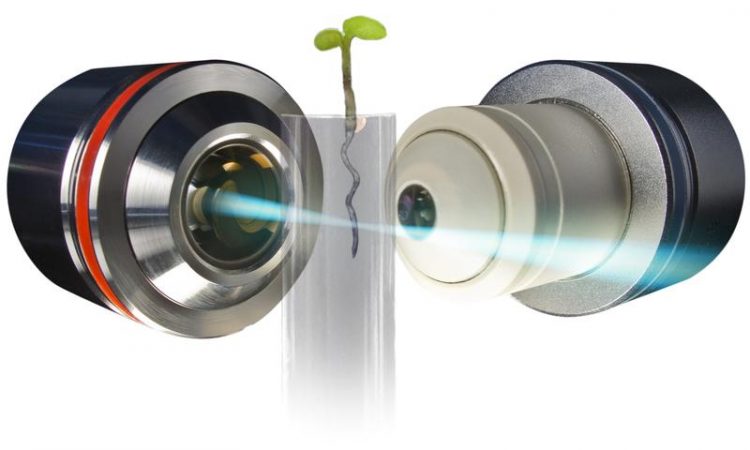How roots find their way to water

The plant (Arabidopsis thaliana) is mounted in a three-dimensional assembly, stands upright in a plant-derived gel appropriate for the species and supplied with medium and light. Image rights: Daniel von Wangenheim.
Plants use their roots to search for water. While the main root digs downwards, a large number of fine lateral roots explore the soil on all sides. As researchers from Nottingham, Heidelberg and Goethe University of Frankfurt report in the current issue of “Nature Plants”, the lateral roots already “know” very early on where they can find water.
For his experiment, Daniel von Wangenheim, a former doctoral researcher in Professor Ernst Stelzer’s Laboratory for Physical Biology and most lately a postdoc at Malcolm Ben-nett’s, mounted thale cress roots along their length in a nutrient solution.
They were, how-ever, not completely immersed and their upper side left exposed to the air. He then ob-served with the help of a high-resolution 3D microscope how the roots branched out.
To his surprise, he discovered that almost as many lateral roots formed on the air side as on the side in contact with the nutrient solution.
As he continued to follow the growth of the roots with each cell division in the microscope, it became evident that the new cells drive the tip of the root in the direction of water from the very outset, meaning that if a lateral root had formed on the air side, it grew in the direction of the agar plate.
“It’s therefore clear that plants first of all spread their roots in all directions, but the root ob-viously knows from the very first cell divisions on where it can find water and nutrients,” says Daniel von Wangenheim, summarizing the results.
“In this way, plants can react flex-ibly to an environment with fluctuating resources.”
The result is based on many hours of film material recorded using Light Sheet Fluores-cence Microscopy (LSFM), a technique developed by Ernst Stelzer. In a vivid video clip, Daniel von Wangenheim shows the root-branching process in slow motion. His tweet has already attracted considerable attention from his colleagues in the field.
https://twitter.com/DvonWangenheim/status/1224365891292405760)
Publication: Daniel von Wangenheim, Jason Banda, Alexander Schmitz, Jens Boland, Anthony Bishopp, Alexis Maizel, Ernst H. K. Stelzer and Malcolm Bennett: Early develop-mental plasticity of lateral roots in response to asymmetric water availability, in Nature Plants (3 February 2020), https://doi.org/10.1038/s41477-019-0580-z)
A picture can be downloaded under: http://www.uni-frankfurt.de/85595433
Caption: Light Sheet Fluorescence Microscopy is based on two processes: 1) lateral illumination of the specimen with laser light along a plane and 2) detection of fluorescent light emitted from a thin volume centred around the illumination plane. The plant (Arabidopsis thaliana) is mounted in a three-dimensional assembly, stands upright in a plant-derived gel appropriate for the species and supplied with medium and light.
Image rights: Daniel von Wangenheim.
Further information: Dr Daniel von Wangenheim, Plant and Crop Sciences, School of Biosci-ences, University of Nottingham, UK, Email: daniel.vonwangenheim@nottingham.ac.uk
Further information: Dr Daniel von Wangenheim, Plant and Crop Sciences, School of Biosci-ences, University of Nottingham, UK, Email: daniel.vonwangenheim@nottingham.ac.uk
Publication: Daniel von Wangenheim, Jason Banda, Alexander Schmitz, Jens Boland, Anthony Bishopp, Alexis Maizel, Ernst H. K. Stelzer and Malcolm Bennett: Early develop-mental plasticity of lateral roots in response to asymmetric water availability, in Nature Plants (3 February 2020), https://doi.org/10.1038/s41477-019-0580-z)
Media Contact
All latest news from the category: Life Sciences and Chemistry
Articles and reports from the Life Sciences and chemistry area deal with applied and basic research into modern biology, chemistry and human medicine.
Valuable information can be found on a range of life sciences fields including bacteriology, biochemistry, bionics, bioinformatics, biophysics, biotechnology, genetics, geobotany, human biology, marine biology, microbiology, molecular biology, cellular biology, zoology, bioinorganic chemistry, microchemistry and environmental chemistry.
Newest articles

Decisive breakthrough for battery production
Storing and utilising energy with innovative sulphur-based cathodes. HU research team develops foundations for sustainable battery technology Electric vehicles and portable electronic devices such as laptops and mobile phones are…

Superradiant atoms could push the boundaries of how precisely time can be measured
Superradiant atoms can help us measure time more precisely than ever. In a new study, researchers from the University of Copenhagen present a new method for measuring the time interval,…

Ion thermoelectric conversion devices for near room temperature
The electrode sheet of the thermoelectric device consists of ionic hydrogel, which is sandwiched between the electrodes to form, and the Prussian blue on the electrode undergoes a redox reaction…





















